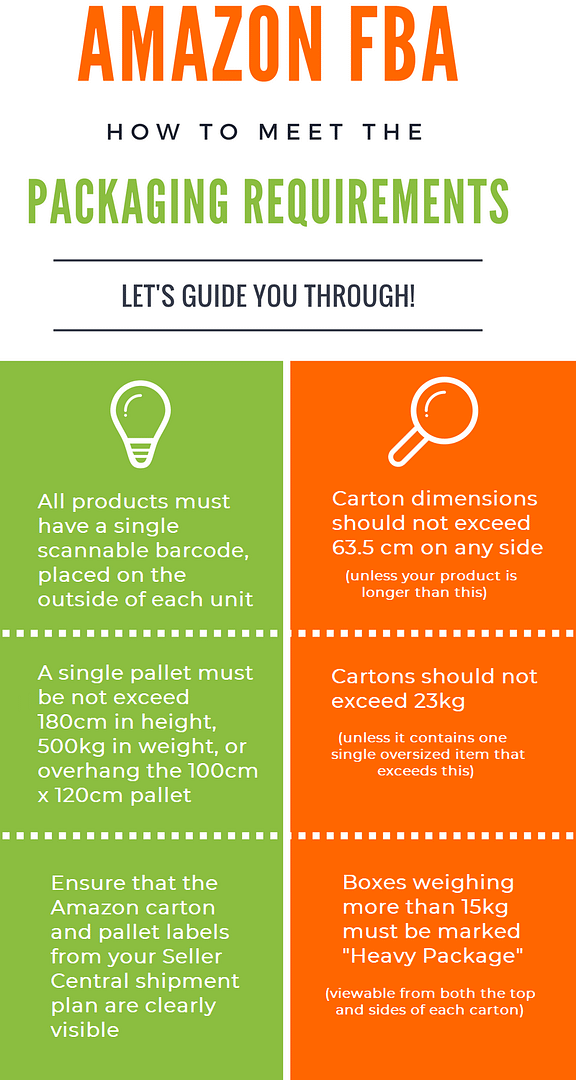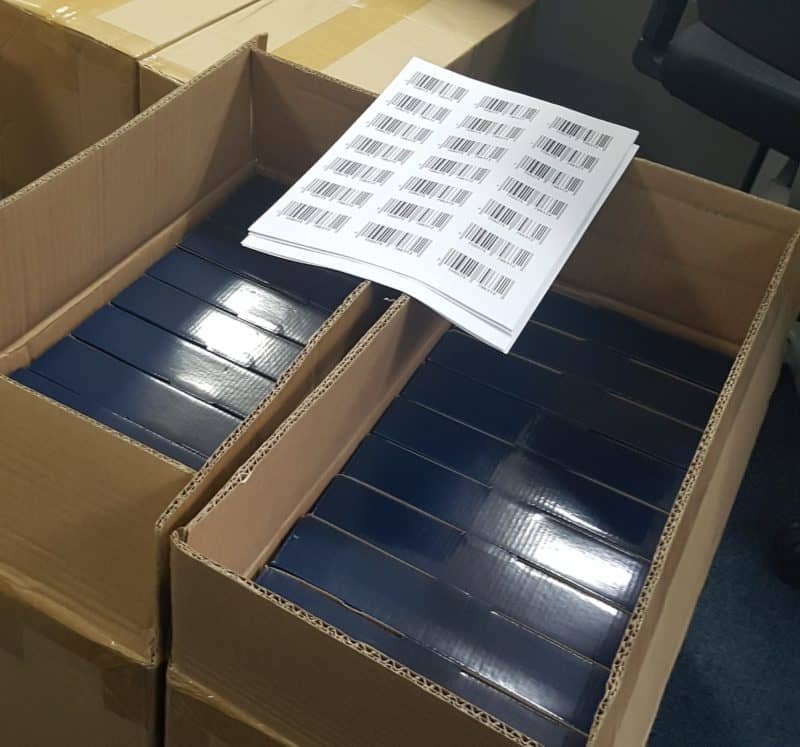This content was reviewed for accuracy on 28/07/2023
Looking for a handy guide to Amazon FBA label requirements? Here is it! Scroll down for info to help you get it right!
Thousands of businesses utilise Amazon FBA. It is efficient and an easy way to completely streamline the selling process; Amazon takes care of everything for you!
A lot of our customers see great success with FBA – in fact, there’s an increasing trend of people importing straight to an FBA warehouse. However, Amazon is very strict in its requirements for acceptance into its FBA warehouses, which means that your goods need to packaged very carefully.
Here, we’re sharing everything that you need to know about Amazon FBA packaging requirements to get your goods to FBA warehouses.
But first – here’s your basic need-to-know info about Amazon FBA.
What Is Amazon FBA?
For those of you who aren’t aware, Amazon FBA (Fulfilled By Amazon) is an Amazon fulfillment service. That means, your goods are sent off to an Amazon warehouse, Amazon store them and, when someone purchases them, Amazon will pack and ship your goods out for you. (If you’re not an Amazon seller, there are other fulfillment services available to you.)
Selling on Amazon FBA is an incredibly easy way to sell because they do all the heavy lifting whilst you earn!
Is Amazon FBA Right For My Business?
Besides the obvious ease of using fulfillment services, having your goods fulfilled by Amazon has numerous other benefits, such as access to Prime customers and easy business growth.
Before you consider it, however, you’ll need to know if Fulfillment By Amazon is right for your business – or if the costs might be a down-side. Here’s our post about Amazon FBA Pros and Cons.
Amazon FBA Specific Requirements
The difficulty with getting your goods delivered straight to an Amazon warehouse is in the packaging. Amazon have very specific requirements and will reject any deliveries that don’t comply.
What does this mean?
This means that you have to be very exact in how you package and palletise your goods. We have already touched on product packaging when discussing how you need to ensure your supplier packages your goods for transit – so now we’re going to talk a little more about how your goods need to be packed for Amazon.

Save
Save
Save
How Individual Goods Have To Be Packaged For Amazon FBA
- All individual SKU items must be contained in the same packaging; if you’re selling a multi-set of a product (for example, book or DVD sets), each set must be packaged in one.NOTE: Amazon do not accept items where the assembly of multiple separate pieces is required – the example given on their site being a wheelbarrow where the handles and legs come in different boxes – delivered to their FBA warehouses.
- Each shippable unit (by this, they mean each unit that will be shipped to your customer; if you are selling a gift set, the entire set would be a shippable unit, but if you were selling the items separately each item would be a shippable unit) has to have a visible barcode.
- Sharp, hazardous, or damage prone goods, need additional protective packaging to ensure that Amazon can complete the fulfillment service safely and without your goods being destroyed.
- If your goods are sensitive to dust, dirt, or humidity they’ll need to be protected by transparent poly bags.NOTE: If Amazon doesn’t feel as though you’ve packaged breakable or dangerous goods sufficiently, they may reject your products or repackage them at your expense – and even throw some non-compliance fees your way.
- Shock-sensitive products, such as hard drives, then each unit must be protectively packaged individually using material such as bubble wrap and all items must be packaged individually.
Labelling the Products

Every item needs a barcode for Amazon. As you can see, the supplier forgot to put them on these products!
Label Requirements For Amazon FBA
Labelling your goods… ensure that:
- You’ve placed the label on a flat surface. If it’s around corners or curves, the label will not be scannable.
- All barcodes aside from your own are covered. More than one visible barcode will interfere with how the warehouse receives your goods and could even result in them being lost – which you obviously don’t want.
- The labels are printed in high-enough quality that they won’t smear or fade: laser jet printers work best for this.

Labelling Cartons For Amazon FBA
Booking a shipment to Amazon FBA on Seller Central, they will raise the labels for your shipment. These will include labels for the pallets and for the individual cartons. We’d suggest that you ask your supplier to label the cartons for you (as they know what’s in each box!).
Each carton on the pallet should not exceed 23 kg. Individual cartons weighing between 15 kg and 23 kg must be marked “Heavy Package” (viewable from both the top and sides of each heavy-weight container).

Now that we’ve gone over how to package and label your goods and their boxes correctly, let’s move on to how to pack them for transportation to the Amazon warehouse. For this, your goods will typically be loaded onto pallets.
Save
Save
How Pallets Have To Be Packaged For Amazon FBA
- Each pallet must be labelled with the Vendor Name, To and From address, PO numbers, Number of cartons, and Pallet #____ of _____ pallets on the upper right corner of one of the sides.
- When quantities allow for it, all pallets must contain like items. All pallets carrying mixed but visually similar products must be labelled “mixed merchandise” or “mixed SKUs” (for example, regular and wide-screen editions of a VHS or DVD that are packaged in similar-looking cartons).
- All pallets must be stretch-wrapped in clear plastic with a “do not break stretch-wrap” or “do not break down” notification to the carrier. Pallets wrapped in black/opaque stretch-wrap may be rejected.
- The pallets used must be standard four-way access pallets of 1,200 mm x 1,000 mm.
- Broken or damaged pallets are not acceptable and may be rejected at the merchant’s expense.
- For single pallets, the pallet height must not exceed 1.8 m (including the height of the pallet).
- The total weight of a pallet must not exceed 500 kg.
- Merchandise must not overhang the pallet edge by more than 25 mm.
Here’s Amazon’s overview

Don’t forget to book the delivery slot . . .
You can’t just palletise your goods to Amazon’s standards and deliver them to the warehouse willy-nilly! Amazon’s delivery system is a well-oiled machine that requires you to book a specific delivery slot. Failing to do this, your delivery WILL be rejected.
When using us to deliver to Amazon we’ll do this for you, using our carrier’s account. If you’re taking care of everything yourself, this is an essential step – you’ll need to be extremely vigilant in meeting Amazon’s delivery schedule.
Here’s what your booking request will look like:

This is the confirmation form Amazon gives you once you schedule your delivery. They’re very particular about delivery times – if your goods arrive late, or even early, they will be rejected.
Save
Save
Save
Save
Save
Save
Save
Save
Can I get my goods imported and delivered straight to an Amazon FBA Warehouse?
Yes, you can!
We can easily arrange for your goods to be delivered to an Amazon FBA warehouse – however, there are a few requirements you will need to meet first.
As you’ve seen above, the packaging and labelling requirements for shipping goods to an Amazon warehouse are extensive.
The good news? An increasing amount of suppliers are familiar with Amazon’s packaging standards as an increasing amount of their customers are starting to import directly to FBA warehouses. All you need to do is ask your supplier to label your goods for you and we take care of the rest!
Want more information on Amazon FBA Labelling Requirements?
If you would like more information, feel free to get in contact with us! We’d be happy to help!
